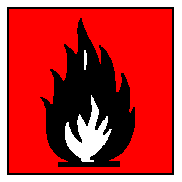International Chemical Safety Cards
| HYDROGEN | ICSC: 0001 |
| HYDROGEN (cylinder) H2 Molecular mass: 2.0 CAS # 1333-74-0 RTECS # MW8900000 ICSC # 0001 UN # 1049 EC # 001-001-00-9 |
 |
| TYPES OF HAZARD/ EXPOSURE |
ACUTE HAZARDS/ SYMPTOMS |
PREVENTION | FIRST AID/ FIRE FIGHTING |
| FIRE | Extremely flammable. Many
reactions may cause fire or explosion. |
NO open flames, NO sparks,
and NO smoking. |
Shut off supply; if not
possible and no risk to surroundings, let the fire burn itself out; (see notes) water
spray, powder, carbon dioxide. |
| EXPLOSION | Gas/air mixtures are
explosive. |
Closed system, ventilation,
explosion-proof electrical equipment and lighting. Use non-sparking handtools. Do not
handle cylinders with oily hands. |
In case of fire: keep
cylinder cool by spraying with water. Combat fire from a sheltered position. |
| EXPOSURE | |
|
|
| INHALATION | Dizziness. Asphyxia.
Laboured breathing. Unconsciousness. |
Closed system and
ventilation. |
Fresh air, rest. Refer for
medical attention. |
| SKIN | ON CONTACT WITH LIQUID:
FROSTBITE. |
Cold-insulating gloves.
Protective clothing. |
ON FROSTBITE: rinse with
plenty of water, do NOT remove clothes. Refer for medical attention. |
| EYES | |
Safety goggles, or face
shield. |
|
| INGESTION | |
|
|
| SPILLAGE DISPOSAL | STORAGE | PACKAGING & LABELLING | ||
| Evacuate danger area!
Consult an expert! Ventilation. Remove vapour with fine water spray. |
Fireproof. Cool. |
F+ symbol R: 12 S: 9-16-33 UN Hazard Class: 2.1 |
||
| SEE IMPORTANT INFORMATION ON BACK | ||||
|
||||